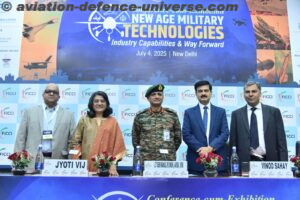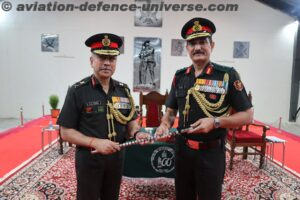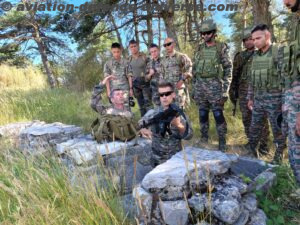- Nation salutes it’s infantry for being there always
By Sangeeta Saxena
New Delhi. 27 October 2024. As the Indian Infantry marks 78 years of it’s existence, the nation joins in, to honour the sacrifices, valour, and resilience of its foot soldiers—warriors who have faced not only the brutalities of battle but also the challenges of “no war, no peace” situations and near-conflict scenarios. Celebrated as the Infantry Day October 27, every year commemorates Indian Infantry’s role as the largest fighting arm of the nation’s Army and its essential contributions to national security.
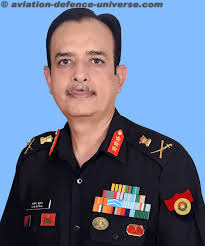 And couldn’t have been a better start to the day, with a message by the DG Infantry to his troops. “On this momentous day, I urge all Infantrymen to rededicate themselves to our core values of bravery, sacrifice, selfless devotion to duty, and professional excellence. May you remain indomitable in your resolve to defend the integrity and sovereignty of our nation,” said Lieutenant General Ajay Kumar, Director General of Infantry.
And couldn’t have been a better start to the day, with a message by the DG Infantry to his troops. “On this momentous day, I urge all Infantrymen to rededicate themselves to our core values of bravery, sacrifice, selfless devotion to duty, and professional excellence. May you remain indomitable in your resolve to defend the integrity and sovereignty of our nation,” said Lieutenant General Ajay Kumar, Director General of Infantry.
Infantry Day holds particular significance, as it marks the landing of Infantrymen at Srinagar airport on October 27, 1947. This critical operation repelled Pakistani-backed tribal invaders, safeguarding Jammu and Kashmir. The event also symbolized India’s first independent military engagement against an aggressor, setting a precedent for the Infantry’s crucial role in preserving the nation’s sovereignty. Field Marshal Montgomery’s words resonate even today: “The least spectacular of all arms, but without which you can do nothing, nothing at all.” Despite technological advancements, it is ultimately the Infantry soldier who captures and holds ground, establishing victory by raising the national flag on contested territories.
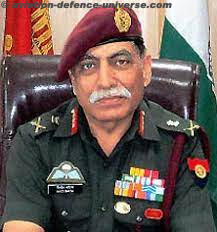 And for us at ADU it couldn’t have been a greater honour than this exclusive statement by a man who lives and breathes Infantry – former DG Infantry , former DGMO & former Director CENJOWS Lt General Vinod Bhatia, PVSM, AVSM, SM ( Retd). “The Indian Infantry is by far the most battle-hardened and combat-rich force in the world, having effectively and successfully fought all wars and executed all operations, ensuring territorial integrity, regional, and internal security. On 27 October 1947, First SIKH spearheaded independent India’s First war, air landing in Srinagar and joining the battle to defeat Pakistan’s intent and intrusions to capture J&K. The infantry has always delivered contributing to national security, be it 1947 – 48, 1962, 1965 , 1971 and 1999 wars, liberation of Goa in 1961, or Countering Insurgencies and terrorism in Nagaland, Mizoram, Manipur, Tripura, Assam and J&K. The infantry has also been in the fore front of regional security in Srilanka and Maldives as also HADR missions in the neighbourhood. The Indian infantry also is one among the largest contributors and contingents to UN Peace Keeping Operations in the world. And one cannot help but remember with moist eyes, the brave infantry soldiers who fought valiantly at Galwan in 2020. It will be repetitive but the fact is India’s contested borders encompass a 126.1 km stretch of the Actual Ground Position Line (AGPL) along the Siachen Glacier, a 742 km-long Line of Control (LoC) in the west, and a 3,488 km-long border with China. Along the Line of Actual Control (LAC), the Indian Army, led by the Infantry, maintains a steadfast stance in response to China’s aggressive actions. Additionally, a significant portion of India’s Infantry is continuously engaged in counter-terrorism operations in Jammu and Kashmir and the Northeast,” exhorted Lt Gen Bhatia.
And for us at ADU it couldn’t have been a greater honour than this exclusive statement by a man who lives and breathes Infantry – former DG Infantry , former DGMO & former Director CENJOWS Lt General Vinod Bhatia, PVSM, AVSM, SM ( Retd). “The Indian Infantry is by far the most battle-hardened and combat-rich force in the world, having effectively and successfully fought all wars and executed all operations, ensuring territorial integrity, regional, and internal security. On 27 October 1947, First SIKH spearheaded independent India’s First war, air landing in Srinagar and joining the battle to defeat Pakistan’s intent and intrusions to capture J&K. The infantry has always delivered contributing to national security, be it 1947 – 48, 1962, 1965 , 1971 and 1999 wars, liberation of Goa in 1961, or Countering Insurgencies and terrorism in Nagaland, Mizoram, Manipur, Tripura, Assam and J&K. The infantry has also been in the fore front of regional security in Srilanka and Maldives as also HADR missions in the neighbourhood. The Indian infantry also is one among the largest contributors and contingents to UN Peace Keeping Operations in the world. And one cannot help but remember with moist eyes, the brave infantry soldiers who fought valiantly at Galwan in 2020. It will be repetitive but the fact is India’s contested borders encompass a 126.1 km stretch of the Actual Ground Position Line (AGPL) along the Siachen Glacier, a 742 km-long Line of Control (LoC) in the west, and a 3,488 km-long border with China. Along the Line of Actual Control (LAC), the Indian Army, led by the Infantry, maintains a steadfast stance in response to China’s aggressive actions. Additionally, a significant portion of India’s Infantry is continuously engaged in counter-terrorism operations in Jammu and Kashmir and the Northeast,” exhorted Lt Gen Bhatia.
The Indian soldier is often described as one who “costs the least but delivers the maximum,” yet the critical question remains: Is the infantry soldier optimally equipped? The answer is in the negative, but the process of transformation in the Indian Army has put a lot of stress on soldier modernisation. It seems an ongoing process but unending. With over 380 battalions, Infantry makes up nearly 38% of the 1.25 million-strong armed forces. The Indian defence industry has here chipped in and taken the task seriously as the nation moves ahead with two clarion calls of Aatmanirbhar Bharat and Make in India. We see indigenous companies in the process of creating protection gear for the soldiers from head to toe and also for all weather conditions.
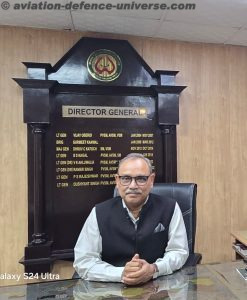 Lt. Gen Dushyant Singh (Retd.) Director General CLAWS said in a statement to ADU said, “Normally one refers to Infantry as the Queen of Battle. Don’t go by gender. Queen implies Shakti which exists in many forms which it takes on to eliminate any adversary. It can be life saviour in calamities or chandi in war. It is the ultimate power of battle. Like Queen of chess it enjoys maximum power. It can go where no one else can go. Until it secures a territory battles victory cannot be claimed. That’s why Indian Infantry has the maximum bravest of the brave 16 PVC awardee. There is a famous quote which is the best expression, ‘When it was victory, the cavalier claimed it outright, the gunner boasted of his calibre, the engineer and signalman publicised their worth, but the infantryman stood silent with victory at his feet’, “.
Lt. Gen Dushyant Singh (Retd.) Director General CLAWS said in a statement to ADU said, “Normally one refers to Infantry as the Queen of Battle. Don’t go by gender. Queen implies Shakti which exists in many forms which it takes on to eliminate any adversary. It can be life saviour in calamities or chandi in war. It is the ultimate power of battle. Like Queen of chess it enjoys maximum power. It can go where no one else can go. Until it secures a territory battles victory cannot be claimed. That’s why Indian Infantry has the maximum bravest of the brave 16 PVC awardee. There is a famous quote which is the best expression, ‘When it was victory, the cavalier claimed it outright, the gunner boasted of his calibre, the engineer and signalman publicised their worth, but the infantryman stood silent with victory at his feet’, “.
As the “Queen of the Battlefield,” the Infantry remains indispensable, ensuring territorial control in times of war, peace, and low-intensity conflict. Units such as the Biharis, Gorkhas, Sikhs, Marathas, Rajputs, Jats and ofcourse the Special Forces, among others, embody this formidable tradition, contributing their strength to the Indian Army. However, the Infantry often operates with limited resources, including outdated equipment and inadequate protective gear. While modernization initiatives are underway, the pace of change must accelerate to meet the demands of contemporary warfare.
The Infantry requires state-of-the-art weaponry, protective gear, surveillance equipment, and communication systems. Currently, the Infantry is trying to fill critical gaps in essential resources, such as advanced rifles, bulletproof vests, night-vision equipment, GPS systems, tactical communication networks to name some advancements and has been successful in starting to move towards the road of sufficiency. Bridging these gaps is vital, as well-equipped soldiers are not only more effective on the battlefield but also enhance the operational readiness of India’s entire armed forces.
Modernizing the Infantry’s arms and equipment is not just a matter of defence—it’s a crucial step toward maintaining India’s strategic advantage and safeguarding its soldiers who, despite limited resources, consistently deliver outstanding results on the ground. Indian Army Infantrymen are now shooting from the new SIG 716 (7.62×51mm) battle at training ranges. At the Korwa Ordnance Factory in Amethi, Uttar Pradesh is producing AK-203 assault rifles in a joint venture between India and Russia. Some step ahead for fulfilling the soldier’s need.
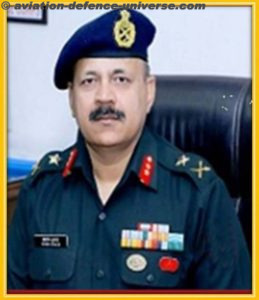 Maj Gen Ashok Kumar (Retd.) Director General CENJOWS speaking with ADU reiterated, “While it is well known that it’s Infantry which finally imposes a nation’s will on the adversary, it’s evolving characteristics in future warfare needs to be appreciated in right earnestness. It is more pronounced due to our mountainous terrain with China and the entire J&K portion with Pakistan. Only a well equipped Infantry will finally seal the day to mark our victory. And it’s high time that we look at our Infantry on this Infantry day more seriously giving it the pre-eminence it deserves. The main credit to get J&K as part of the Indian Union goes exclusively to our Infantry soldiers. It is this very day which is rightly celebrated as Infantry Day. Given the collusivity of our Northern and Western neighbours, it is a must that we take a pledge as a nation to modernise our infantry in a mission mode.”
Maj Gen Ashok Kumar (Retd.) Director General CENJOWS speaking with ADU reiterated, “While it is well known that it’s Infantry which finally imposes a nation’s will on the adversary, it’s evolving characteristics in future warfare needs to be appreciated in right earnestness. It is more pronounced due to our mountainous terrain with China and the entire J&K portion with Pakistan. Only a well equipped Infantry will finally seal the day to mark our victory. And it’s high time that we look at our Infantry on this Infantry day more seriously giving it the pre-eminence it deserves. The main credit to get J&K as part of the Indian Union goes exclusively to our Infantry soldiers. It is this very day which is rightly celebrated as Infantry Day. Given the collusivity of our Northern and Western neighbours, it is a must that we take a pledge as a nation to modernise our infantry in a mission mode.”
The Indian Army’s modernization efforts, including the Future Infantry Soldier As a System (F-INSAS) program, aim to enhance lethality, survivability, and mobility. The hope is that modernization will continue, equipping the Infantry to meet the challenges of today’s dynamic combat environment.
Throughout India’s military history, the Infantry has been the backbone of the Indian Army, known for its physical endurance, discipline, and combat effectiveness. Despite resource limitations, Infantry soldiers continue to bear the brunt of battle, demonstrating their commitment to protecting the nation. Success is not final, failure is not fatal: it is the courage to continue that counts said Winston S. Churchill and I am sure he had the infantry man in mind.
The Infantry Regiments of the Indian Army stand as a steadfast pillar of national defence, bearing a legacy of courage and valour that stretches back centuries. These regiments, each steeped in rich traditions and unique war cries, have established themselves as one of the world’s most respected military institutions. Delving into their history and ethos reveals a profound dedication to the nation and an unbreakable spirit.
 Prime Minister Narendra Modi took to his twitter handle early morning today to wish the nations Infantry a happy raising day. He tweeted, “On Infantry Day, we all salute the indomitable spirit and courage of all Ranks and Veterans of the Infantry, who tirelessly protect us. They always stand resolute in the face of any adversity, ensuring the safety and security of our nation. The infantry embodies the essence of strength, valour and duty, inspiring every Indian.”
Prime Minister Narendra Modi took to his twitter handle early morning today to wish the nations Infantry a happy raising day. He tweeted, “On Infantry Day, we all salute the indomitable spirit and courage of all Ranks and Veterans of the Infantry, who tirelessly protect us. They always stand resolute in the face of any adversity, ensuring the safety and security of our nation. The infantry embodies the essence of strength, valour and duty, inspiring every Indian.”
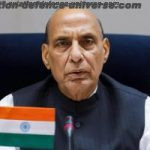 Defence Minister Rajnath Singh also took to X to wish the Infantry. “Greetings and best wishes to all ranks of the Indian Infantry on Infantry Day. Infantry plays a pivotal role in protecting our country. Their courage, valour and sacrifice continue to inspire everyone. India is proud of its brave infantry personnel,” he messaged.
Defence Minister Rajnath Singh also took to X to wish the Infantry. “Greetings and best wishes to all ranks of the Indian Infantry on Infantry Day. Infantry plays a pivotal role in protecting our country. Their courage, valour and sacrifice continue to inspire everyone. India is proud of its brave infantry personnel,” he messaged.
As the backbone of India’s military might, the Infantry is uniquely specialized in ground warfare, operating across a variety of challenging terrains. These regiments encompass specialized units such as light, mountain, motorized, marine, mechanized, and airborne divisions, each trained to excel in different combat environments. Unlike other formations, Infantry operates as a distinct military organization, with battalions deployed across divisions and corps during operations, ensuring their expertise supports a range of strategic needs.
The Indian Army’s Infantry Regiments do not function as a single field formation but as the largest, most essential element within the Infantry division. While Infantry battalions are rarely deployed as one cohesive unit, their distributed presence across formations and commands provides critical flexibility and strength during combat. Each battalion embodies the ethos of bravery and resilience, confronting the adversary on foot, whether in peacetime or during conflict.
 In essence, the Indian Army’s Infantry represents not just the physical might of the military, but the enduring spirit of India’s defence. Their role, fundamental to national security, continues to uphold the values of sacrifice, honour, and duty that have defined their storied legacy.
In essence, the Indian Army’s Infantry represents not just the physical might of the military, but the enduring spirit of India’s defence. Their role, fundamental to national security, continues to uphold the values of sacrifice, honour, and duty that have defined their storied legacy.
Unlike advanced machinery and high-tech weaponry, the foot soldier confronts danger face-to-face, relying on physical endurance, courage, and loyalty to protect the homeland. These soldiers endure harsh climates, treacherous terrains, and challenging conditions, often stationed far from loved ones, yet they remain steadfast in their mission to ensure the safety and security of others. Their sacrifices, often invisible to the public eye, are a reminder of the selflessness that forms the backbone of a nation’s defence. For this, the soldier on foot is revered, not only as a protector of borders but as a symbol of the resilience and valour that defines a nation. The soldier on foot always lives in our hearts!
Infantry Day every year reminds us of all our heroes who stand strong to keep us safe. ADU salutes the Indian Infantry.



































